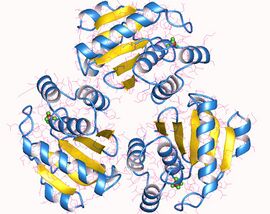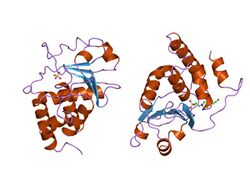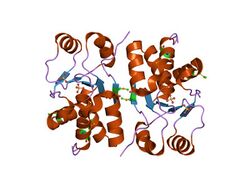Biology:Protein tyrosine phosphatase
| Protein-tyrosine-phosphatase | |||||||||
|---|---|---|---|---|---|---|---|---|---|
 Protein tyrosine phosphatase 1, trimer, Human | |||||||||
| Identifiers | |||||||||
| EC number | 3.1.3.48 | ||||||||
| CAS number | 79747-53-8 | ||||||||
| Databases | |||||||||
| IntEnz | IntEnz view | ||||||||
| BRENDA | BRENDA entry | ||||||||
| ExPASy | NiceZyme view | ||||||||
| KEGG | KEGG entry | ||||||||
| MetaCyc | metabolic pathway | ||||||||
| PRIAM | profile | ||||||||
| PDB structures | RCSB PDB PDBe PDBsum | ||||||||
| |||||||||
Protein tyrosine phosphatases (EC 3.1.3.48, systematic name protein-tyrosine-phosphate phosphohydrolase) are a group of enzymes that remove phosphate groups from phosphorylated tyrosine residues on proteins:
- [a protein]-tyrosine phosphate + H2O = [a protein]-tyrosine + phosphate
Protein tyrosine (pTyr) phosphorylation is a common post-translational modification that can create novel recognition motifs for protein interactions and cellular localization, affect protein stability, and regulate enzyme activity. As a consequence, maintaining an appropriate level of protein tyrosine phosphorylation is essential for many cellular functions. Tyrosine-specific protein phosphatases (PTPase; EC 3.1.3.48) catalyse the removal of a phosphate group attached to a tyrosine residue, using a cysteinyl-phosphate enzyme intermediate. These enzymes are key regulatory components in signal transduction pathways (such as the MAP kinase pathway) and cell cycle control, and are important in the control of cell growth, proliferation, differentiation, transformation, and synaptic plasticity.[1][2][3][4]
Functions
Together with tyrosine kinases, PTPs regulate the phosphorylation state of many important signalling molecules, such as the MAP kinase family. PTPs are increasingly viewed as integral components of signal transduction cascades, despite less study and understanding compared to tyrosine kinases.
PTPs have been implicated in regulation of many cellular processes, including, but not limited to:
- Cell growth
- Cellular differentiation
- Mitotic cycles
- Oncogenic transformation
- Receptor endocytosis[5]
Classification
By mechanism
PTP activity can be found in four protein families.[6][7]
Links to all 107 members of the protein tyrosine phosphatase family can be found in the template at the bottom of this article.
Class I
The class I PTPs, are the largest group of PTPs with 99 members, which can be further subdivided into
- 38 classical PTPs
- 21 receptor tyrosine phosphatases
- 17 nonreceptor-type PTPs
- 61 VH-1-like or dual-specific phosphatases (DSPs)
- 11 MAPK phosphatases (MPKs)
- 3 Slingshots
- 3 PRLs
- 4 CDC14s
- 19 atypical DSPs
- 5 phosphatase and tensin homologs (PTENs)
- 16 myotubularins
Dual-specificity phosphatases (dTyr and dSer/dThr) dual-specificity protein-tyrosine phosphatases. Ser/Thr and Tyr dual-specificity phosphatases are a group of enzymes with both Ser/Thr (EC 3.1.3.16) and tyrosine-specific protein phosphatase (EC 3.1.3.48) activity able to remove the serine/threonine or the tyrosine-bound phosphate group from a wide range of phosphoproteins, including a number of enzymes that have been phosphorylated under the action of a kinase. Dual-specificity protein phosphatases (DSPs) regulate mitogenic signal transduction and control the cell cycle.
LEOPARD syndrome, Noonan syndrome, and metachondromatosis are associated with PTPN11.
Elevated levels of activated PTPN5 negatively affects synaptic stability and plays a role in Alzheimer's disease,[3] Fragile X syndrome,[4] schizophrenia,[8] and Parkinson's disease.[9] Decreased levels of PTPN5 has been implicated in Huntington's disease,[10][11] brain ischemia,[12] alcohol use disorder,[13][14] and stress disorders.[15][16] Together these findings indicate that only at optimal levels of PTPN5 is synaptic function unimpaired.
Class II
LMW (low-molecular-weight) phosphatases, or acid phosphatases, act on tyrosine phosphorylated proteins, low-MW aryl phosphates and natural and synthetic acyl phosphates.[17][18]
The class II PTPs contain only one member, low-molecular-weight phosphotyrosine phosphatase (LMPTP).
Class III
Cdc25 phosphatases (dTyr and/or dThr)
The Class III PTPs contains three members, CDC25 A, B, and C
Class IV
These are members of the HAD fold and superfamily, and include phosphatases specific to pTyr and pSer/Thr as well as small molecule phosphatases and other enzymes.[19] The subfamily EYA (eyes absent) is believed to be pTyr-specific, and has four members in human, EYA1, EYA2, EYA3, and EYA4. This class has a distinct catalytic mechanism from the other three classes.[20]
By location
Based on their cellular localization, PTPases are also classified as:
- Receptor-like, which are transmembrane receptors that contain PTPase domains.[21] In terms of structure, all known receptor PTPases are made up of a variable-length extracellular domain, followed by a transmembrane region and a C-terminal catalytic cytoplasmic domain. Some of the receptor PTPases contain fibronectin type III (FN-III) repeats, immunoglobulin-like domains, MAM domains, or carbonic anhydrase-like domains in their extracellular region. In general, the cytoplasmic region contains two copies of the PTPase domain. The first seems to have enzymatic activity, whereas the second is inactive.
- Non-receptor (intracellular) PTPases[22]
Common elements
All PTPases, other than those of the EYA family, carry the highly conserved active site motif C(X)5R (PTP signature motif), employ a common catalytic mechanism, and possess a similar core structure made of a central parallel beta-sheet with flanking alpha-helices containing a beta-loop-alpha-loop that encompasses the PTP signature motif.[23] Functional diversity between PTPases is endowed by regulatory domains and subunits.
|
|
| ||||||||||||||||||||||||||||||||||||||||||||||||||||||||||||||||||||||||||||||||||||||||||||||||
|
| ||||||||||||||||||||||||||||||||||||||||||||||||
Expression pattern
Individual PTPs may be expressed by all cell types, or their expression may be strictly tissue-specific. Most cells express 30% to 60% of all the PTPs, however hematopoietic and neuronal cells express a higher number of PTPs in comparison to other cell types. T cells and B cells of hematopoietic origin express around 60 to 70 different PTPs. The expression of several PTPS is restricted to hematopoietic cells, for example, LYP, SHP1, CD45, and HePTP.[28] The expression of PTPN5 is restricted to the brain. Differential expression of PTPN5 is found in many brain regions, with no expression in the cerebellum.[29][30][31]
References
- ↑ "Protein tyrosine phosphatases: mechanisms of catalysis and regulation". Curr Opin Chem Biol 2 (5): 633–41. 2018. doi:10.1016/S1367-5931(98)80095-1. PMID 9818190.
- ↑ "Receptor and nonreceptor protein tyrosine phosphatases in the nervous system". Cell. Mol. Life Sci. 60 (11): 2465–82. 2020. doi:10.1007/s00018-003-3123-7. PMID 14625689.
- ↑ 3.0 3.1 "Genetic reduction of striatal-enriched tyrosine phosphatase (STEP) reverses cognitive and cellular deficits in an Alzheimer's disease mouse model". Proceedings of the National Academy of Sciences of the United States of America 107 (44): 19014–9. Nov 2018. doi:10.1073/pnas.1013543107. PMID 20956308. Bibcode: 2010PNAS..10719014Z.
- ↑ 4.0 4.1 "Genetic manipulation of STEP reverses behavioral abnormalities in a fragile X syndrome mouse model". Genes, Brain and Behavior 11 (5): 586–600. Jul 2019. doi:10.1111/j.1601-183X.2012.00781.x. PMID 22405502.
- ↑ "Abeta-mediated NMDA receptor endocytosis in Alzheimer's disease involves ubiquitination of the tyrosine phosphatase STEP61". The Journal of Neuroscience 30 (17): 5948–57. Apr 2022. doi:10.1523/JNEUROSCI.0157-10.2010. PMID 20427654.
- ↑ "An overview of the protein tyrosine phosphatase superfamily". Curr Top Med Chem 3 (7): 739–48. 2017. doi:10.2174/1568026033452302. PMID 12678841.
- ↑ "Protein tyrosine phosphatases in the human genome". Cell 117 (6): 699–711. 2020. doi:10.1016/j.cell.2004.05.018. PMID 15186772.
- ↑ "The tyrosine phosphatase STEP: implications in schizophrenia and the molecular mechanism underlying antipsychotic medications". Translational Psychiatry 2 (7): e137. 2021. doi:10.1038/tp.2012.63. PMID 22781170.
- ↑ "STEP61 is a substrate of the E3 ligase parkin and is upregulated in Parkinson's disease". Proceedings of the National Academy of Sciences of the United States of America 112 (4): 1202–7. Jan 2018. doi:10.1073/pnas.1417423112. PMID 25583483. Bibcode: 2015PNAS..112.1202K.
- ↑ "Striatal-enriched protein tyrosine phosphatase expression and activity in Huntington's disease: a STEP in the resistance to excitotoxicity". The Journal of Neuroscience 31 (22): 8150–62. Jun 2021. doi:10.1523/JNEUROSCI.3446-10.2011. PMID 21632937.
- ↑ "Calpain and STriatal-Enriched protein tyrosine phosphatase (STEP) activation contribute to extrasynaptic NMDA receptor localization in a Huntington's disease mouse model". Human Molecular Genetics 21 (17): 3739–52. Sep 2020. doi:10.1093/hmg/dds154. PMID 22523092.
- ↑ "Neuroprotective role of a brain-enriched tyrosine phosphatase, STEP, in focal cerebral ischemia". The Journal of Neuroscience 33 (45): 17814–26. Nov 2020. doi:10.1523/JNEUROSCI.2346-12.2020. PMID 24198371.
- ↑ "Alcohol inhibition of the NMDA receptor function, long-term potentiation, and fear learning requires striatal-enriched protein tyrosine phosphatase". Proceedings of the National Academy of Sciences of the United States of America 108 (16): 6650–5. Apr 2020. doi:10.1073/pnas.1017856108. PMID 21464302. Bibcode: 2011PNAS..108.6650H.
- ↑ "Inhibition of striatal-enriched tyrosine phosphatase 61 in the dorsomedial striatum is sufficient to increased ethanol consumption". Journal of Neurochemistry 129 (6): 1024–34. Jun 2019. doi:10.1111/jnc.12701. PMID 24588427.
- ↑ "A critical role for protein tyrosine phosphatase nonreceptor type 5 in determining individual susceptibility to develop stress-related cognitive and morphological changes". The Journal of Neuroscience 32 (22): 7550–62. May 2022. doi:10.1523/JNEUROSCI.5902-11.2022. PMID 22649233.
- ↑ "Striatal-enriched protein tyrosine phosphatase-STEPs toward understanding chronic stress-induced activation of corticotrophin releasing factor neurons in the rat bed nucleus of the stria terminalis". Biological Psychiatry 74 (11): 817–26. Dec 2020. doi:10.1016/j.biopsych.2013.07.032. PMID 24012328.
- ↑ "Sequencing, cloning, and expression of human red cell-type acid phosphatase, a cytoplasmic phosphotyrosyl protein phosphatase". J. Biol. Chem. 267 (15): 10856–10865. 2023. doi:10.1016/S0021-9258(19)50097-7. PMID 1587862.
- ↑ "Identification of the adipocyte acid phosphatase as a PAO-sensitive tyrosyl phosphatase". Protein Sci. 1 (6): 710–721. 1992. doi:10.1002/pro.5560010603. PMID 1304913.
- ↑ "Genomics and evolution of protein phosphatases". Science Signaling 10 (474): eaag1796. April 2023. doi:10.1126/scisignal.aag1796. PMID 28400531.
- ↑ Plaxton, William C.; McManus, Michael T. (2020). Control of primary metabolism in plants. Wiley-Blackwell. pp. 130–. ISBN 978-1-4051-3096-7. https://books.google.com/books?id=U-8GgunwoRYC&pg=PA130. Retrieved 12 December 2020.
- ↑ "The crystal structure of human receptor protein tyrosine phosphatase kappa phosphatase domain 1". Protein Sci. 15 (6): 1500–1505. 2006. doi:10.1110/ps.062128706. PMID 16672235.
- ↑ Perrimon N, Johnson MR, Perkins LA, Melnick MB (2018). "The nonreceptor protein tyrosine phosphatase corkscrew functions in multiple receptor tyrosine kinase pathways in Drosophila". Dev. Biol. 180 (1): 63–81. doi:10.1006/dbio.1996.0285. PMID 8948575.
- ↑ "The structure and mechanism of protein phosphatase s: insights into catalysis and regulation". Annu. Rev. Biophys. Biomol. Struct. 27 (1): 133–64. 2021. doi:10.1146/annurev.biophys.27.1.133. PMID 9646865.
- ↑ "The crystal structure of a low-molecular-weight phosphotyrosine protein phosphatase". Nature 370 (6490): 575–8. August 1994. doi:10.1038/370575a0. PMID 8052313. Bibcode: 1994Natur.370..575S.
- ↑ "Crystal structure of Yersinia protein tyrosine phosphatase at 2.5 A and the complex with tungstate". Nature 370 (6490): 571–5. August 1994. doi:10.1038/370571a0. PMID 8052312. Bibcode: 1994Natur.370..571S. https://deepblue.lib.umich.edu/bitstream/2027.42/62819/1/370571a0.pdf.
- ↑ "Crystal structure of the dual specificity protein phosphatase VHR". Science 272 (5266): 1328–31. May 1996. doi:10.1126/science.272.5266.1328. PMID 8650541. Bibcode: 1996Sci...272.1328Y.
- ↑ "Structural and functional characterization of a novel phosphatase from the Arabidopsis thaliana gene locus At1g05000". Proteins 73 (1): 241–53. October 2008. doi:10.1002/prot.22041. PMID 18433060.
- ↑ "Protein tyrosine phosphatases and the immune response". Nat. Rev. Immunol. 5 (1): 43–57. 2018. doi:10.1038/nri1530. PMID 15630428.
- ↑ "Molecular characterization of a protein-tyrosine-phosphatase enriched in striatum". Proceedings of the National Academy of Sciences of the United States of America 88 (16): 7242–6. Aug 2021. doi:10.1073/pnas.88.16.7242. PMID 1714595. Bibcode: 1991PNAS...88.7242L.
- ↑ "STEP61: a member of a family of brain-enriched PTPs is localized to the endoplasmic reticulum". The Journal of Neuroscience 16 (24): 7821–31. Dec 2021. doi:10.1523/JNEUROSCI.16-24-07821.2021. PMID 8987810.
- ↑ "A protein tyrosine phosphatase expressed within dopaminoceptive neurons of the basal ganglia and related structures". The Journal of Neuroscience 13 (7): 3064–74. Jul 2021. doi:10.1523/JNEUROSCI.13-07-03064.2021. PMID 8331384.
Sources
External links
- PTP Summary and Relevant Publications at Monash University
- Protein-Tyrosine-Phosphatase at the US National Library of Medicine Medical Subject Headings (MeSH)
- EC 3.1.3.48
 |





